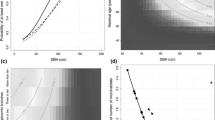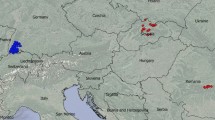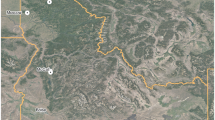Abstract
Recent studies have highlighted the key role of tree microhabitats in forest habitat complexity and have suggested using them as surrogates for local taxonomic biodiversity. However, few practical guidelines have been published to help foresters in managing microhabitats at the stand scale. This paper provides scientific background information to help to develop such guidelines. We surveyed trees in nine long-unmanaged beech–fir forests to model tree microhabitat occurrence and diversity at the tree level. Data were upscaled to a size range of tree cluster, i.e., at the tree population scale, by aggregating observed values of microhabitat occurrence. Accumulation curves were used to estimate the minimum number of trees required to make all the microhabitat types available. Two managed forests were then studied to quantify management effects on microhabitats. Diameter at breast height (dbh) and tree species, respectively, explained 16 and 10 % of the variations in the number of microhabitat-bearing trees, and 21 and 10 % for the number of microhabitat types. Beech trees and firs with a dbh of less than dbh 50 and 65 cm, respectively, did not ensure the provision of all microhabitat types. At least 20 ha of unmanaged forest were necessary to conserve all the microhabitat types. Current management practices have reduced the number of microhabitat-bearing beeches both by reducing the number of very large trees (dbh > 67.5 cm) and by tree selection within mid-size diameters. For fir, only the logging of very large trees (dbh > 62.5 cm) negatively affected microhabitats. These figures may inspire guidelines for conservation-friendly forestry.





Similar content being viewed by others
References
Agresti A (2002) Categorical data analysis. Wiley, London
Andren H (1994) Effects of habitat fragmentation on birds and mammals in landscapes with different proportions of suitable habitat: a review. Oikos 71:355–366
Angelstam P, Roberge JM, Axelsson R, Elbakidze M, Bergman KO, Dahlberg A, Degerman E, Eggers S, Esseen PA, Hjalten J, Johansson T, Müller J, Paltto H, Snall T, Soloviy I, Tornblom J (2013) Evidence-based knowledge versus negotiated indicators for assessment of ecological sustainability: the Swedish Forest Stewardship Council Standard as a case study. Ambio 42:229–240
Bardat J, Bioret F, Botineau M, Boullet V, Delpech R, Géhu JM, Haury J, Lacoste A, Rameau JC, Royer JM, Roux G, Touffet J (2004) Prodrome des végétations de France. MNHN, Paris
Bastien Y, Gauberville C (coord.) (2011) Vocabulaire forestier. Écologie, gestion et conservation des espaces boisés. IDF/CNPF, AgroParisTech, ONF
Bitterlich W (1984) The relascope idea: relative measurements in forestry. Commonwealth Agricultural Bureaux, Farnham Royal
Blondel J (2005) Bois mort et à cavités: leur rôle pour l’avifaune cavicole. In: Vallauri D et al (eds) Bois morts et à cavités: une clé pour des forêts vivantes. Tec et Doc Lavoisier, Paris, pp 137–142
Bouget C, Gosselin F (2005) Distribution spatiale du bois mort: enjeux pour la conservation des espèces cavicoles et saproxyliques. In: Vallauri D et al (eds) Bois morts et à cavités: une clé pour des forêts vivantes. Tec et Doc Lavoisier, Paris, pp 107–113
Bouget C, Larrieu L, Brin A (2014) Key features for saproxylic biodiversity from rapid habitat assessment in temperate forests. Ecol Indic 36:656–664
Brunet J, Fritz Ö, Richnau G (2010) Biodiversity in European beech forests: a review with recommendations for sustainable forest management. Ecol Bull 53:77–94
Bütler R, Angelstam P, Ekelund P, Schlaeffer R (2004) Dead wood threshold values for the three-toed woodpecker presence in boreal and sub-Alpine forest. Biol Conserv 119:305–318
Canty A, Ripley B (2012) Boot: bootstrap R (S-plus) functions. R package version 1.3–7
Cooke HA, Hannon SJ (2012) Nest-site selection by old boreal forest cavity excavators as a basis for structural retention guidelines in spatially-aggregated harvests. For Ecol Manage 269:37–51
Cramp S (ed) (1980) Handbook of the birds of Europe the Middle East and North Africa. The birds of the Western Paleartic. Oxford University Press, New York
Eskelson BNI, Temesgen H, Barrett TM (2009) Estimating cavity tree and snag abundance using negative binomial regression models and nearest neighbor imputation methods. Can J For Res 39:1749–1765
EUFORGEN (2012) Distribution map of silver fir (Abies alba) and European beech (Fagus sylvatica). http://www.euforgen.org
Fahrig L (1998) When does fragmentation of breeding habitat affect population survival? Ecol Model 105:273–292
Fahrig L (2001) How much habitat is enough? Biol Conserv 100:65–74
Fan ZF, Larsen DR, Shifley SR, Thompson FR (2003) Estimating cavity tree abundance by stand age and basal area, Missouri, USA. For Ecol Manag 179:231–242
Fan ZF, Shifley SR, Thompson FR, Larsen DR (2004) Simulated cavity tree dynamics under alternative timber harvest regimes. For Ecol Manag 193:399–412
Fan ZF, Shifley SR, Spetich MA, Thompson FR, Larsen DR (2005) Abundance and size distribution of cavity trees in second-growth and old-growth central hardwood forests. North J Appl For 22:162–169
Gibbons P, McElhinny C, Lindenmayer DB (2010) What strategies are effective for perpetuating structures provided by old trees in harvested forests? A case study on trees with hollows in south-eastern Australia. For Ecol Manag 260:975–982
Gossner M, Lachat T, Brunet J, Isacsson G, Bouget C, Brustel H, Brandl R, Weisser W, Müller J (2013) Current “near-to-nature” forest management effects on functional trait composition of saproxylic beetles in beech forests. Conserv Biol 27:605–614
Gotelli NJ, Colwell RK (2001) Quantifying biodiversity: procedures and pitfalls in the measurement and comparison of species richness. Ecol Lett 4:379–391
Gouix N, Mertlik J, Jarzabek-Mueller A, Nemeth T, Brustel H (2012) Known status of the endangered western Palaearctic violet click beetle (Limoniscus violaceus) (Coleoptera). J Nat Hist 46:769–802
Grove SJ (2002) Saproxylic insect ecology and the sustainable management of forests. Annu Rev Ecol Syst 33:1–23
Gwaze D, Elliott A (2011) Cavity trees, snags, and overstory density in a riparian forest in North-eastern Missouri. North J Appl For 28:105–109
Hosmer DW, Lemeshow S (2000) Applied Logistic Regression, 2nd edn. Wiley, London
Jakoby O, Rademacher C, Grimm V (2010) Modelling dead wood islands in European beech forests: how much and how reliably would they provide dead wood? Eur J For Res 129:659–668
Kanold A, Rohrmann N, Müller J (2009) Einflussfaktoren auf das Baumhöhlenangebot und dessen Auswirkungen auf die Arten und Dichten von Höhlenbrütern in Bergwäldern. Ornithologischer Anzeiger 47:116–129
Kehler D, Bondrup-Nielsen S (1999) Effects of isolation on the occurrence of a fungivorous forest beetle, Bolitotherus cornutus, at different spatial scales in fragmented and continuous forests. Oikos 84:35–43
Larrieu L, Cabanettes A (2012) Species, live status, and diameter are important tree features for diversity and abundance of tree microhabitats in subnatural montane beech-fir forests. Can J For Res 42:1433–1445
Larrieu L, Cabanettes A, Delarue A (2012) Impact of silviculture on dead wood and on the distribution and frequency of tree microhabitats in montane beech–fir forests of the Pyrenees. Eur J For Res 131:773–786
Larsson TB (ed) (2001) Biodiversity evaluation tools for European forests. Ecol Bull 50:1–240
Lee S, Fan Z (2012) Effect of spatial scale on modeling and predicting mean cavity tree density: a comparison of modeling methods. Open J For 2(4):219–224. doi:10.4236/ojf.2012.24027
Lindenmayer DB, Franklin JF (2002) Conserving forest biodiversity: a comprehensive multi-scaled approach. Island Press, Washington
MCPFE (2007) State of Europe’s forests. In: The MCPFE report on sustainable forest management in Europe. Ministerial conference on the protection of forests in Europe. Warsaw, Poland
Menard S (2002) Applied logistic regression analysis, 2nd ed. Series: Quantitative applications in the social sciences, no. 106. Sage Publications, Beverley Hills
Meschede A, Heller KG (2003) Ecologie et protection des chauves-souris en milieu forestier. Le Rhinolophe 16:1–248
Métailié JP (2001) Un patrimoine historico-environnemental: les forêts pastorales dans les Pyrénées. Actes du 126 ème congrès national des sociétés historiques et scientifiques. Paysages, territoires et aménagement dans le sud de la France. Toulouse, 33–47
Michel AK, Winter S (2009) Tree microhabitat structures as indicators of biodiversity in Douglas-fir forests of different stand ages and management histories in the Pacific Northwest, USA. For Ecol Manag 257:1453–1464
Michel AK, Winter S, Linde A (2011) The effect of tree dimension on the diversity of bark microhabitat structures and bark use in Douglas-fir (Pseudotsuga menziesii var. menziesii). Can J For Res 41:300–308
Möller G (2009) Habitats and Substrates of Saproxylic Invertebrates, mainly beetles. Dissertation Freien Universität, Berlin
Moning C, Müller J (2009) Critical forest age thresholds for diversity of lichens, molluscs and birds in temperate beech (Fagus sylvatica L.) plant communities. Ecol Indic 9:922–932
Müller J (2005) Waldstrukturen als Steuergröße für Artengemeinschaften in kollinen bis submontanen Buchenwäldern. In: Wissenschaftszentrum Weihenstephan für Ernährung, Landnutzung und Umwelt. Technische Universität, München, http://mediatum.ub.tum.de, p 197
Müller J, Bütler R (2010) A review of habitat thresholds for dead wood: a baseline for management recommendations. Eur J For Res 129:981–992
Müller J, Brunet J, Brin A, Bouget C, Brustel H, Bussler H, Förster B, Isacsson G, Köhler F, Lachat T, Gossner M (2012) Implications from large-scale spatial diversity patterns of saproxylic beetles for the conservation of European Beech forests. Insect Conserv Diver. doi:10.1111/j.1752-4598.2012.00200.x
Nakazawa M (2012) Package ‘fmsb’. http://cran.r-project.org/web/packages/fmsb/fmsb.pdf
Nilsson SG, Hedin J, Niklasson M (2001) Biodiversity and its assessment in boreal and nemoral forests. Scand J For Res 10–26
Oksanen J, Blanchet FG, Kindt R, Legendre P, Minchin PR, O’Hara RB, Simpson GL, Solymos P, Stevens MHH, Wagner H (2011) ‘Vegan’ package: community ecology package. http://cran.r-project.org/web/packages/vegan/vegan.pdf
ONF (2009) Conservation de la biodiversité dans la gestion courante des forêts publiques. INS-09-T-71, Paris
Pardé J, Bouchon J (1988) Dendrométrie. ENGREF, Nancy
PEFC France (2011) Cahier des charges relatif à la gestion durable de la forêt. http://www.pefc-france.org
R Development Core Team (2011) R: a language and environment for statistical computing. Vienna Austria, R Foundation for Statistical Computing
Ranius T (2000) Minimum viable metapopulation size of a beetle, Osmoderma eremita, living in tree hollows. Anim Conserv 3:37–43
Ranius T, Fahrig L (2006) Targets for maintenance of dead wood for biodiversity conservation based on extinction thresholds. Scand J For Res 21:201–208
Ranius T, Niklasson M, Berg N (2009) Development of tree hollows in pedunculate oak (Quercus robur). For Ecol Manag 257:303–310
Remm J, Lohmus A (2011) Tree cavities in forests: the broad distribution pattern of a keystone structure for biodiversity. For Ecol Manag 262:579–585
Remm J, Lohmus A, Remm K (2006) Tree cavities in riverine forests: what determines their occurrence and use by hole-nesting passerines? For Ecol Manag 221:267–277
Robles H, Ciudad C, Matthysen E (2011) Tree-cavity occurrence, cavity occupation and reproductive performance of secondary cavity-nesting birds in oak forests: the role of traditional management practices. For Ecol Manag 261:1428–1435
Robles H, Ciudad C, Matthysen E (2012) Responses to experimental reduction and increase of cavities by a secondary cavity-nesting bird community in cavity-rich Pyrenean oak forests. For Ecol Manag 277:46–53
Schall P, Ammer C (2013) How to quantify forest management intensity in Central European forests. Eur J For Res 132:379–396
Stokland JN, Siitonen J, Jonsson BG (2012) Biodiversity in deadwood. Cambridge University Press, Cambridge
Thompson LA (2009) R (and S-PLUS) Manual to Accompany Agresti’s Categorical Data Analysis (2002). 2nd edition, 276 p. http://www.math.tau.ac.il/~yekutiel/CDA/Thompson_manual.pdf
Vuidot A, Paillet Y, Archaux F, Gosselin F (2011) Influence of tree characteristics and forest management on tree microhabitats. Biol Conserv 144:441–450
Wegge P, Rolstad J (1986) The spacing of capercaillie leaks in relation to habitat and social organization. Behav Ecol Sociobiol 19:401–408
Wiktander U, Olsson O, Nilsson S (2001) Seasonal variation in home range size, and habitat area requirement of the lesser spotted wood pecker Dendrocopos minor. Biol Conserv 100:387–395
Winter S, Möller GC (2008) Microhabitats in lowland beech forests as monitoring tool for nature conservation. For Ecol Manag 255:1251–1261
Acknowledgments
This study was financed with the help of European funds (FEDER) and French Grants (State and Conseil régional de Midi-Pyrénées). We wish to thank Mathilde Harel and Antoine Delarue for their help in the field. We also thank the two anonymous reviewers for their valuable comments on the previous manuscript and Vicki Moore for improving the English.
Author information
Authors and Affiliations
Corresponding author
Additional information
Communicated by C. Ammer.
Electronic supplementary material
Below is the link to the electronic supplementary material.
Rights and permissions
About this article
Cite this article
Larrieu, L., Cabanettes, A., Brin, A. et al. Tree microhabitats at the stand scale in montane beech–fir forests: practical information for taxa conservation in forestry. Eur J Forest Res 133, 355–367 (2014). https://doi.org/10.1007/s10342-013-0767-1
Received:
Revised:
Accepted:
Published:
Issue Date:
DOI: https://doi.org/10.1007/s10342-013-0767-1




